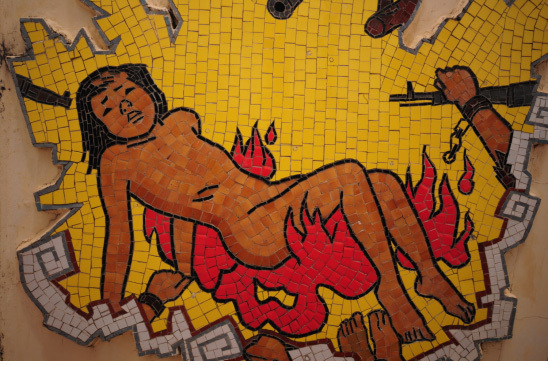 |
|
A mosaic portrays a 1966 massacre at Binh Hoa Village in Binh Dinh Province by South Korean troops during the Vietnam War. (provided by Ku Su-jeong)
|
On my trip into Vietnam’s past, I mourned with survivors of massacres perpetrated by South Korean troops
In our first meeting early this year after exchanging emails, Korea-Vietnam Peace Foundation board member Ku Su-jeong immediately suggested that I accompany her on Mar. 11 to a 50th anniversary memorial ceremony at the village of Ha My in Vietnam’s Quang Nam Province. She said it would be the first time a Republic of Korea National Assembly member attended a ceremony for victims of civilian massacres by South Korean troops. When I finally arrived at the village of Phong Nhi and Phong Nhat near Da Nang and stood before the stone memorial, what I saw took my breath away. Inscribed on the stone were serial numbers, along with the victims’ dates of birth: 1968, 1967, 1967, 1967, 1966, 1965, 1964, 1964, 1963, 1963, 1963, 1963, 1962, 1961, 1961, 1961, 1960, 1960, 1960, 1960, 1960, 1959. What had happened here? The massacre took place on Feb. 12, 1968. There’s no need to work the numbers out – these were young children. Even someone born in 1959 would not have yet turned ten. The victims’ names were of course engraved on the stone as well. The guide explained to me that “Thi” is a common name among Vietnamese women. Most of the names of adults on the stone had “Thi” in them. The majority of the 74 victims were women and children. This was not only the case at Phong Nhi/Phong Nhat – the same was true for the 135 victims at Ha My. Many of them were children who died before even being given a name by their parents. At every village we visited, we were told the victims had been unarmed. Yet all of them were slain, from newborn babies to pregnant mothers. The sites of the massacres were mainly air-raid shelters and the yards of houses. I was dumbfounded. The survivors of that day raged: war or not, why did they massacre children? Why had they themselves been spared? How could such terrible suffering be inflicted? The trip lasted for three days, but no journey in my life has ever felt longer or more painful. My heart and body ached. I fell to my knees. At the Ha My memorial ceremony, I prostrated myself and apologized. I begged forgiveness in front of survivors who had recorded on the wall of a tomb for nine family members slain there that this was a war crime committed by South Korean soldiers. We wept together.
 |
|
President Moon Jae-in and his wife Kim Jung-sook wave as they arrive at Noi Bai International Airport in Hanoi on Mar. 22. (Blue House Photo Pool)
|






